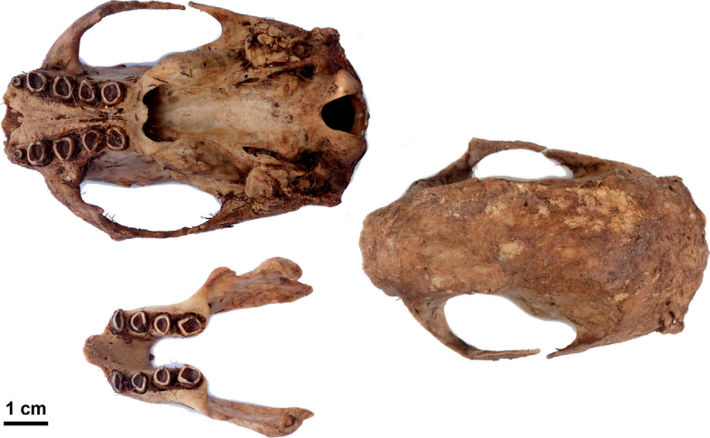Consumption of a maned sloth (Bradypus torquatus Illiger, 1811) by a tiger shark (Galeocerdo cuvier Péron & LeSueur, 1822) in southeastern Brazil
DOI:
https://doi.org/10.31687/saremNMS.21.2.2Palabras clave:
aquatic dispersal, diet, Pilosa, threatenedResumen
We present the first record of maned sloth (Bradypus torquatus) consumption by the tiger shark (Galeocerdo cuvier). Our record is based on the analysis of stomach contents of a tiger shark captured off the coast of Rio de Janeiro state, southeastern Brazil. Although it is not possible to distinguish between a predation and scavenging event, we consider it likely that the sloth was consumed while dispersing between the islands of the region. We also comment on the heretofore unforeseen risks of aquatic dispersal by xenartrans.
Citas
Anderson, R. P., & C. O. Handley Jr. 2001. A new species of three-toed sloth (Mammalia: Xenarthra) from Panamá, with a review of the genus Bradypus. Proceedings of the Biological Society of Washington 114:1–33.
Barbosa-Filho, M. L. V., E. M. Costa-Neto, P. Ribeiro, M. R. Alvarez, & R. R. Nóbrega Alves. 2016. Armadillo consumption by a tiger shark: an ethnozoological contribution. Edentata: The newsletter of the IUCN/SSC Anteater, Sloth and Armadillo Specialist Group. 17:41–45.
Beebe, W. 1926. The three-toed sloth, Bradypus cuculliger cuculliger Wagler. Zoologica 7:1–67.
Bornatowski, H., & V. Abilhoa. 2012. Tubarões e raias capturados pela pesca artesanal no Paraná: guia de identificação. Hori Cadernos Técnicos nº 4, Hori Consultoria Ambiental, Curitiba, Paraná.
Bornatowski, H., M. D. C. Robert, & L. Costa. 2007. Dados sobre a alimentação de jovens de tubarão-tigre, Galeocerdo cuvier (Péron & Lesueur) (Elasmobranchii, Carcharhinidae), do sul do Brasil. PanAmerican Journal of Aquatic Sciences 2:10–3.
Bornatowski, H., M. R. Heithaus, C. M. P. Batista, & R. Mascarenhas. 2012a . Shark scavenging and predation on sea turtles in northeastern Brazil. Amphibia-Reptilia 33:495–502.
Bornatowski, H., L. L. Wedekin, M. R. Heithaus, M. C. C. Marcondes, & M. R. Rossi-Santos. 2012b. Shark scavenging and predation on cetaceans at Abrolhos Bank, eastern Brazil. Journal of the Marine Biological Association of the United Kingdom 92:1767–1772.
Chiarello, A. G. 2008. Sloth Ecology: An overview of field studies: The Biology of the Xenarthra. Chapter 25 in: The Biology of the Xenarthra (S. F. Vizcaíno & W. J. Loughry, eds.). University Press of Florida, Gainesville.
Chiarello, A., & N. Moraes-Barros. 2014. Bradypus torquatus. The IUCN Red List of Threatened Species 2014. http://dx.doi.org/10.2305/IUCN.UK.2014-1.RLTS.T3036A47436575.en. (4 December 2019).
Compagno, L. J. V. 1984. FAO Species Catalogue: Sharks of the world – An Annotated and Illustrated Catalogue of Shark Species Known to Date. United Nations Development Programme, Food and Agriculture Organization of the United Nations (FAO), United Nations (UN), Rome, Italy, V. 4, Part 2 – Carcharhiniformes.
Dicken, M. L., et al. 2017. Diet and trophic ecology of the tiger shark (Galeocerdo cuvier) from South African waters. PLoS ONE 12:e0177897.
Ebert, D. A., S. Fowler, & L. Compagno. 2013. Sharks of the World: A Fully Illustrated Guide. Wild Nature Press, Princeton University Press, New Jersey.
Esser, H., D. Brown, & Y. Liefting. 2010. Swimming in the Northern Tamandua (Tamandua mexicana) in Panama. Edentata 11:70–72.
Gibb, G. C., et al. 2016. Shotgun Mitogenomics Provides a Reference Phylogenetic Framework and Timescale for Living Xenarthrans. Molecular Biology and Evolution 33:621–642.
Gomes, U. L., C. N. Signori, O. B. F. Gadig, & U. R. S. Santos. 2010. Guia para identificação de tubarões e raias do Rio de Janeiro. 1ª edição. Technical Books Editora, Rio de Janeiro.
Hayssen, V. 2009. Bradypus torquatus (Pilosa: Bradypodidae). Mammalian Species 829:1–5.
Heithaus, M. R. 2001. The biology of tiger sharks, Galeocerdo cuvier, in Shark Bay, Western Australia: Sex ratio, size distribution, diet, and seasonal changes in catch rates. Environmental Biology of Fishes 61:25–36.
Hirsch, A., & A. G. Chiarello. 2012. The endangered maned sloth Bradypus torquatus of the Brazilian Atlantic forest: a review and update of geographical distribution and habitat preferences. Mammal Review 42:35–54.
Meyer, C. G., J. M. O'Malley, Y. P. Papastamatiou, J. J. Dale, M. R. Hutchinson, J. M. Anderson, M. A. Royer, & K. N. Holland. 2014. Growth and maximum size of tiger sharks (Galeocerdo cuvier) in Hawaii. PLoS ONE 9:e84799.
Montgomery, G. G., & M. E. Sunquist. 1975. Impact of Sloths on Neotropical Forest Energy Flow and Nutrient Cycling. Tropical Ecological Systems: Trends in Terrestrial and Aquatic Research (F. B. Golley & E. Medina, eds.). Springer-Verlag, New York.
Rada, D. P., G. H. Burgess, R. S. Rosa, & O. B. F. Gadig. 2015. Necrophagy of a nurse shark (Ginglymostoma cirratum) by tiger sharks (Galeocerdo cuvier). Universitas Scientiarum 20:313–320.
Simpfendorfer, C. A., A. B. Goodreid, & R. B. McAuley. 2001. Size, sex and geographic variation in the diet of the tiger shark, Galeocerdo cuvier, from Western Australian waters. Environmental Biology of Fishes 61:37–46.
Taulman, J. F., & L. W. Robbins. 1996. Recent range expansion and distributional limits of the nine-banded armadillo (Dasypus novemcinctus) in the United States. Journal of Biogeography 23:635–648.
Worman, R. G. 1946. Swimming Sloth. Natural History, New York. 55:49.

Descargas
Publicado
Cómo citar
Número
Sección
Licencia
Derechos de autor 2021 Flavia R. Miranda, Paloma M. Santos

Esta obra está bajo una licencia internacional Creative Commons Atribución-NoComercial 4.0.

